Rural Life and Society | Chapter 3 | History | 8th Social Science - Peasants Revolts | 8th Social Science : History : Chapter 3 : Rural Life and Society
Chapter: 8th Social Science : History : Chapter 3 : Rural Life and Society
Peasants Revolts
Peasants
Revolts
The
British rule in India brought about many changes in the agrarian system in the
country. The old agrarian system collapsed and under the new system, the
ownership of land was conferred on the Zamindars. They tried to extract as much
as they could from the cultivators of land. The life of the peasants was
extremely miserable. The various peasant movements and uprisings during the
19th and 20th centuries were in the nature of a protest against of the existing
conditions under which their exploitation knew no limits.
The Santhal Rebellion
(1855-56)
The
first revolt which can be regarded as peasants’ revolt was the Santhal
Rebellion in 1855-56. The land near the hills of Rajmahal in Bihar was
cultivated by the Santhals. The landlords and money-lenders from the cities
took advantage of their ignorance and began grabbing their lands. This created
bitter resentment among them leading to their armed uprising in 1855.
Consequently, under the belief of a divine order, around 10,000 Santals
gathered under two Santhal brothers, Siddhu and Kanhu, to free their country of
the foreign oppressors and set up a government of their own. The rebellion
assumed a formidable shape within a month. The houses of the European planters,
British officers, railway engineers, zamindars and money-lenders were attacked.
The rebellion continued till February 1856, when the rebel leaders were
captured and the movement was put down with a heavy hand. The government
declared the Parganas inhabited by them as Santhal Parganas so that their lands
and identity could be safeguarded from external encroachments.

Indigo Revolt
(1859-60)
The
Bengal indigo cultivators strike was the most militant and widespread peasant
uprisings. The European indigo planters compelled the tenant farmers to grow
indigo at terms highly disadvantageous to the farmers. The tenant farmer was
forced to sell it cheap to the planter and accepted advances from the planter
that benefitted the latter. There were also cases of kidnapping, looting,
flogging and burning. Led by Digambar Biswas and Bishnu Charan Biswas, the
ryots of Nadia district gave up indigo cultivation in September 1859. Factories
were burnt down and the revolt spread. To take control of the situation, the
Government set up an indigo commission in 1860 whose recommendations formed
part of the Act VI of 1862. The indigo planters of Bengal, however, moved on to
settle in Bihar and Uttar Pradesh. The newspaper, Hindu Patriot brought to
light the misery of the cultivators several times. Dinabandhu Mitra wrote a
drama, Nil-Darpan, in Bengali with a view to draw the attention of the people
and the government towards the misery of the indigo-cultivators.
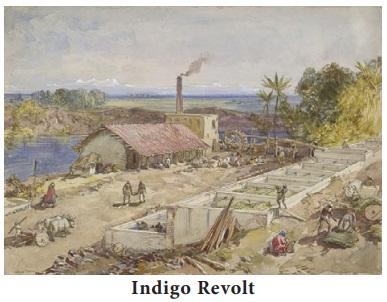
Pabna Revolt (1873-76)
Pabna
Peasant Uprising was a resistance movement by the peasants against the
oppression of the Zamindars. It originated in the Yusufshahi pargana of Pabna
in Bengal. It was led by Keshab Chandra Roy. The zamindars routinely collected
money from the peasants by the illegal means of forced levy, abwabs, enhanced
rent and so on. Peasants were often evicted from land on the pretext of
non-payment of rent.
Large
crowds of peasants gathered and marched through villages frightening the
zamindars and appealing to other peasants to join with them. Funds were raised
from the ryots to meet the costs. The struggle gradually spread throughout
Pabna and then to the other districts of East Bengal. Everywhere agrarian
leagues were organized. The main form of struggle was that of legal resistance.
There was very little violence. It occurred only when the zamindars tried to
compel the riots to submit to their terms by force. There were only a few cases
of looting of the houses of the zamindars. A few attacks on police stations
took place and the peasants also resisted attempts to execute court decrees.
Hardly zamindars or zamindar’s agent were killed or seriously injured. In the
course of the movement, the riots developed a strong awareness of the law and
their legal rights and the ability to combine and form associations for
peaceful agitation.
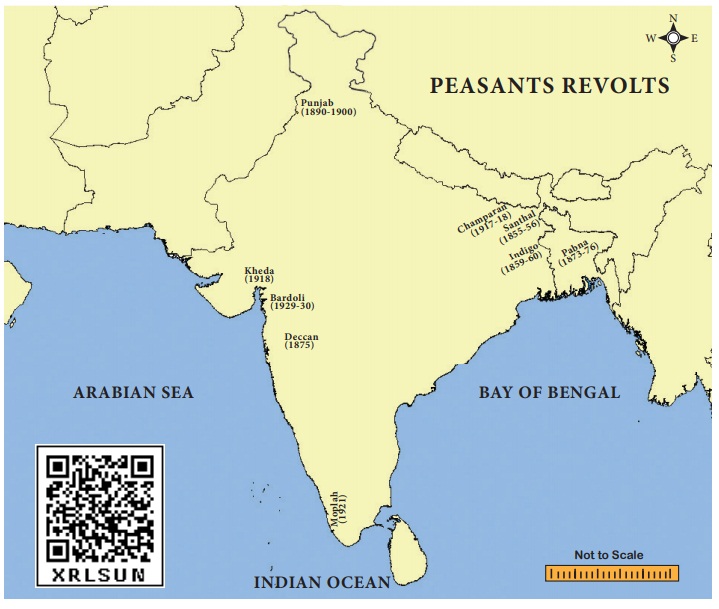
Deccan Riots (1875)
In
1875, the peasants revolted in the district of Poona, that event has been
called the ‘Deccan Riots’. The peasants revolted primarily against the
oppression of local moneylenders who were grabbing their lands systematically.
The uprising started from a village in Poona district when the village people
forced out a local moneylender from the village and captured his property.
Gradually, the uprising spread over 33 villages and the peasants looted the
property of Marwari Sahukars. The uprising turned into violent when the
Sahukars took help of the police. It was suppressed only when the army was
called to control it. However, it resulted in passing of the Deccan
Agriculturists Relief Act’ which removed some of the most serious grievances of
the peasants.
Punjab Peasant
Movement (1890-1900)
The
peasants of the Punjab agitated to prevent the rapid alienation of their lands
to the urban moneylenders for failure to pay debts. The British India did not
want any revolt in that province which provided a large number of soldiers to
the British army in India. In order to protect the peasants of the Punjab, the
Punjab Land Alienation Act was passed in 1900 “as an experimental measure” to
be extended to the rest of India if it worked successfully in the Punjab. The
Act divided the population of the Punjab into three categories viz., the
agricultural classes, the statutory agriculturist class and the rest of the
population including the moneylenders. Restrictions were imposed on the sale and
mortgage of the land from the first category to the other two categories.
Champaran Satyagraha
(1917-18)
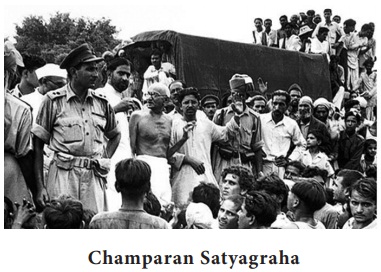
The
European planters of Champaran in Bihar resorted to illegal and inhuman methods
of indigo cultivation at a cost which was wholly unjust. Under the Tinkathia
system in Champaran, the peasants were bound by law to grow indigo on 3/20 part
of their land and send the same to the British planters at prices fixed by
them. They were liable to unlawful extortion and oppression by the planters.
Mahatma Gandhi took up their cause. The Government appointed an enquiry
commission of which Mahatma Gandhi was a member. The grievances of the peasants
were enquired and ultimately the Champaran Agrarian Act was passed in May 1918.
Kheda (Kaira)
Satyagraha (1918)
In the Kheda District of Gujarat,
due to constant famines, agriculture failed in 1918, but the officers insisted
on collection of full land revenue. The local peasants, therefore, started a
‘no-tax’ movement in Kheda district in 1918. Gandhi accepted the leadership of
this movement.
Gandhiji organised the peasants to
offer Satyagraha and opposed official insistence on full collection of
oppressive land revenue despite the conditions of famine. He inspired the
peasants to be fearless and face all consequences. The response to his call was
unprecedented and the government had to bow to a settlement with the peasants.
Sardar Vallabhbhai Patel emerged as an important leader of the Indian freedom
struggle during this period.
Moplah Rebellion (1921)
The Muslim Moplah (or Moplah)
peasants of Malabar (Kerala) was suppressed and exploited by the Hindu
zamindars (Jenmis) and British government. This was the main cause of this
revolt.
The
Moplah peasants got momentum from the Malabar District Conference, held in
April 1920. This conference supported the tenants’ cause, and demanded
legislations for regulating landlord-tenant relations. In August 1921, the
Moplah tenants rebelled against the oppressive zamindars. In the initial phase
of the rebellion, the Moplah peasants attacked the police stations, public
offices, communications and houses of oppressive landlords and moneylenders. By
December 1921, the government ruthlessly suppressed the Moplah rebellion.
According to an official estimate, as a result of government intervention, 2337
Moplah rebels were killed, 1650 wounded and more than 45,000 captured as
prisoners.
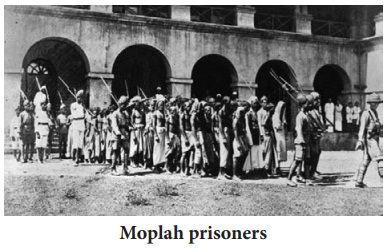
Bardoli
Satyagraha (1929-30)
In 1928, the peasants of Bardoli
(Gujarat) started their agitation under the leadership of Sardar Vallabhbhai
Patel, in protest against the government’s proposal to increase land revenue by
30 percent. The peasants refused to pay tax at the enhanced rate and started
no-tax campaign from 12 February 1928. Many women also participated in this
campaign.
In
1930, the peasants of Bardoli rose to a man, refused to pay taxes, faced the
auction sales and the eventual loss of almost all of their lands but refused to
submit to the Government.
However,
all their lands were returned to them when the Congress came to power in 1937.
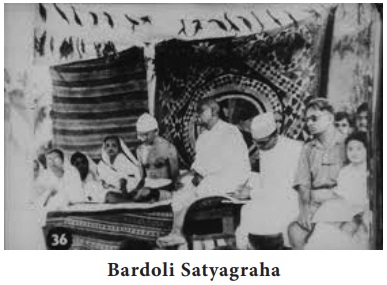
Related Topics